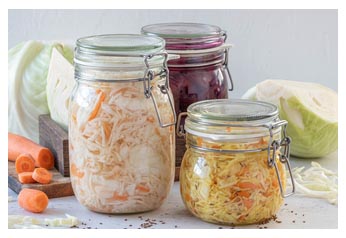
By Susan Glassman and Lisa Peterson
Probiotic-rich foods can enhance digestion and improve overall gut health. All are produced through fermentation, a food preservation method that has been used for thousands of years to naturally reduce the risk of food spoilage and foodborne illness. Common foods include sourdough bread, kombucha, yogurt, pickles, and sauerkraut.
Sauerkraut – or sour cabbage – is a traditional German food with Chinese origins that can be made at home. It’s high in vitamin C and low-calorie at only 42 calories per cup. To make sauerkraut, follow a research-based recipe from the National Center for Home Food Preservation or a state Cooperative Extension.
Experts emphasize following food safety measures when fermenting foods in a home kitchen.
“Washing your hands is an important first step,” said Susan Glassman, University of Illinois Extension nutrition and wellness educator. “Always prepare kitchen equipment by washing it in hot soapy water and using a sanitizing solution.”
Sauerkraut’s characteristic tangy flavor comes from lactic acid produced during the brining process by Lactobacillus, a beneficial bacterium. The brine – or salt solution – allows the helpful bacteria to thrive while inhibiting the growth of harmful bacteria, which can cause food to spoil.
Tips for making homemade sauerkraut
Start with high-quality vegetables free from disease or spoilage. Choose firm, sweet, and mature heads of cabbage and use a quality water supply and quality salt. Filtered water is preferred, and canning or pickling salt is recommended.
Suitable containers for fermenting and storing sauerkraut include stone crocks free of lead glazing or containers made of food-grade plastic or glass.
“Use a tamping or pounding tool to release the mixture’s natural juices when packing shredded cabbage into containers,” said Glassman. “If you don’t have a tool, massage the mixture by hand for several minutes before packing it.”
Submerge the packed mixture 1 to 2 inches under the brine solution while fermenting to control mold. The USDA Complete Guide to Home Canning recommends using weights or food-grade bags filled with brine and covered with a glass plate to keep cabbage submerged.
For best quality, store sauerkraut at 70º to 75ºF while fermenting for 3 to 4 weeks. Watch for signs that the product is ready to move into cold storage, such as bubbling, a sour aroma, and a sour taste.
Fully fermented kraut may be stored tightly covered in the refrigerator and is safe to eat for several months. For unrefrigerated, shelf-stable storage, process sauerkraut in a boiling water bath canner following recommended processing times at appropriate altitude.
Before enjoying sauerkraut, rinse to remove excess sodium, which is high due to the fermentation process. Try adding it to a burger or sandwich, potatoes, dips, sushi bowls, or tacos.
The health benefits of fermented foods are due to the presence of probiotics, but not all fermented foods contain probiotics, Glassman said. When purchasing fermented foods, check the label for “live active cultures” to confirm the food’s probiotic benefits.
For more information on preserving food safely, visit Illinois Extension’s food preservation website or connect with your local Extension office: go.illinois.edu/ExtensionOffice.
Susan Glassman and Lisa Peterson are nutrition and wellness educators at the University of Illinois Extension
—University of Illinois Extension

